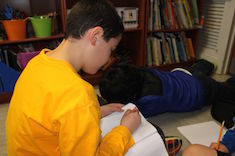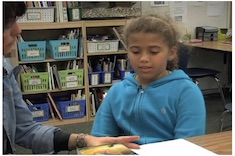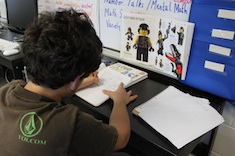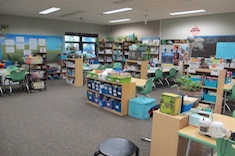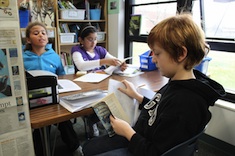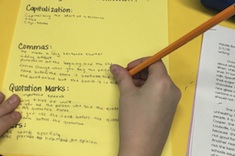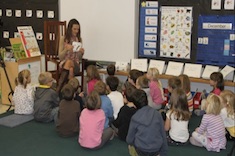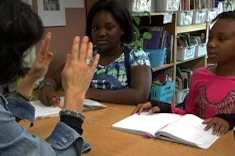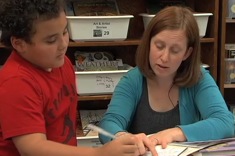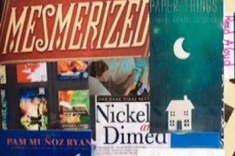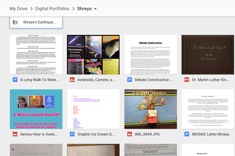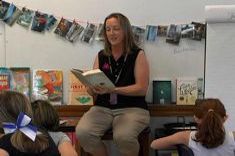4th
Latest Content
Minilesson: Measurable Reading Goals in Fourth Grade
Gigi McAllister has her fourth graders consider what makes a reading goal measurable.
Celebrating Completed Books and Presenting New Ones
Gigi McAllister shares a quick daily routine of asking students to celebrate books they have finished reading before she introduces a new book to the class.
Growing Writing Stamina
Tara Barnett and Kate Mills have a confession to make: in the first weeks of school, many of their fourth-grade students didn’t write much at all in workshops. It was only after tackling the issue of writing stamina head-on that they saw rapid progress.
Getting Started with Voice Recorded Responses
Gigi MicAllister gives step-by-step advice on how she set up voice-recorded response as an option in her fourth-grade classroom.
Supporting Brave Writers
Tara Barnett and Kate Mills use the Sara Bareilles song “Brave” to help their fourth-grade students move from bed-to-bed stories to more emotive writing early in the year.
Partner Conference: Audiobooks to Support Comprehension
In this week's video, Gigi McAllister meets with two fourth graders who are reading the book Paper Things, talking about how using an audiobook can support comprehension.
Branding Blogs (Part 3)
Andrea Smith concludes her series on the power of branded student blogs in her fourth-grade classroom.
Best First Drafts
Ruth Ayres confers with fourth grader Nicole and reinforces advice from her mom about capitalizing proper nouns, as well as the importance of applying what you know about conventions in first drafts.
Previewing a Book with Zoe
Andrea Smith uses a reading conference with fourth grader Zoe to preview a book.
Bridging the Gap Between Intervention and the Classroom
Kate Mills and Tara Barnett share strategies for building bridges between intervention and classroom instruction.
Charts as Tools, Charts as Teachers
Tara Barnett and Kate Mills give three principles they use to help avoid the “charts as wallpaper” syndrome in their fourth-grade classroom.
Mentors for Process and Habits
Ruth Ayres shares some of her favorite mentors and mentor texts for developing good writing processes and habits.
Introducing the Classroom Library
Andrea Smith shares a sequence of lessons she uses to introduce the classroom library to her fourth-grade students.
Prepping the Meeting Area for Success
Tara Barnett and Kate Mills describe how they set up their meeting area with the right supplies to build community and student independence.
Student-Centered Room Setup
Tara Barnett and Kate Mills describe the principles they use to design a student-centered classroom.
Trying on Books for Reading Groups
Gigi McAllister finds taking time to have students browse texts before forming book clubs makes all the difference in the quality of the discussions.
A Place to Belong
Andrea Smith reflects on preparing to say goodbye to students and her teaching partner of many years. If you have a favorite colleague who is retiring, you may want to get a hankie ready before you read this one.
An Individualized Conventions Checklist
Melanie Meehan finds that a flexible conventions checklist that students develop according to their own needs is the best way to ensure conventions are taught in the context of authentic student work.
Strategies for Elaboration in Opinion Writing
Melanie Meehan works with fifth graders who are struggling to elaborate on themes in their opinion writing.
Weaving in Poetry
Gigi McAllister shares suggestions for infusing poetry throughout classrooms and the literacy curriculum all year long.
Owl Research Brainstorming: Partner Work
Andrea Smith’s fourth graders are working on an Owl Research project that integrates reading, writing, talking, listening, and content literacy.
Alternatives to Home/School Reading Logs
There may be few literacy homework assignments more despised by families than the dreaded reading log. Gigi McAllister proposes some alternatives, and explains how she keeps families in the loop on reading progress.
Reorganizing the Classroom Library
Gigi McAllister reorganizes her classroom library checkout system, and finds that a little upfront investment in time pays big dividends all year long.
Restarting a Writing Draft in Fourth Grade
Beth Lawson confers with Michael, a fourth-grade writer who struggles with focus and basic conventions.
Using Reading Notebook Covers for Reflection and Goal Setting
Clare Landrigan and Tammy Mulligan are using reading notebook covers in ingenious ways.
Getting Started with Digital Portfolios
Megan Skogstad shares advice launching digital portfolios.
Staying True to Best Practices with Required Resources
Are you required to use a reading or writing program that goes against your beliefs about teaching and learning? Gigi McAllister has suggestions for holding onto your beliefs and sanity.
Launching Student Data Binders
Megan Skogstad shares lots of practical advice for creating and sustaining student data binders.
Strategies for Using Reader’s Notebooks
Melanie Swider enhances read alouds and the entire reading workshop with creative uses for reading notebooks.
Fourth-Grade Read Aloud: Checking In
In this video from a fourth-grade classroom, Gi Reed reads aloud Small as an Elephant by Jennifer Richard Jacobson. Gi continually checks in with her students, making sure they are visualizing, noticing new vocabulary, and making connections to earlier incidents in the texts—all without breaking the flow of the story.
Browse Content By
Type
Category
- Assessment Tools
- Big Fresh Archives
- Booklists
- Choice Numeracy
- Classroom Design
- Common Core
- Community Building
- Conferring
- Content Literacy
- Digital Literacy
- English Language Learners
- Equity
- Family Relations
- Free Samples
- Guiding Groups
- Leadership
- Literacy Coaches
- Mentor Texts
- Minilessons
- New Teacher Mentors
- Podcasts
- Poetry
- Quote Collections
- Reading Strategies
- Self Care
- Struggling and Striving Learners
- Talking and Listening
- Teacher Study Groups
- Teaching Reading
- Teaching Writing
- Word Study and Vocabulary
Author
- Melissa Quimby
- Nawal Qarooni
- Gwen Blumberg
- Julie Cox
- The Lead Learners
- Hannah Tills
- Josie Stewart
- Ruth Metcalfe
- Mallory Messenger
- Becca Burk
- Jodie Bailey
- Vivian Chen
- Mary Brower
- Tiffany Abbott Fuller
- Stephanie Affinito
- Ruth Ayres
- Leigh Anne Eck
- Heather Fisher
- Shari Frost
- Julie Johnson
- Suzy Kaback
- Gigi McAllister
- Shirl McPhillips
- Melanie Meehan
- Cathy Mere
- Debbie Miller
- Tara Barnett and Kate Mills
- Tammy Mulligan
- Dana Murphy
- Bitsy Parks
- David Pittman
- Brenda Power
- Heather Rader
- Matt Renwick
- Mandy Robek
- Christy Rush-Levine
- Gretchen Schroeder
- Jen Schwanke
- Brian Sepe
- Katherine Sokolowski
- Stella Villalba
- Jennifer Vincent
Grade Level
Choice Literacy Membership
Articles
Get full access to all Choice Literacy article content
Videos
Get full access to all Choice Literacy video content
Courses
Access Choice Literacy course curriculum and training



